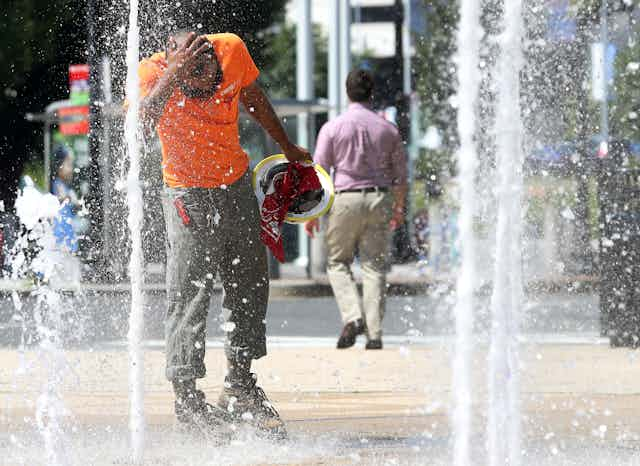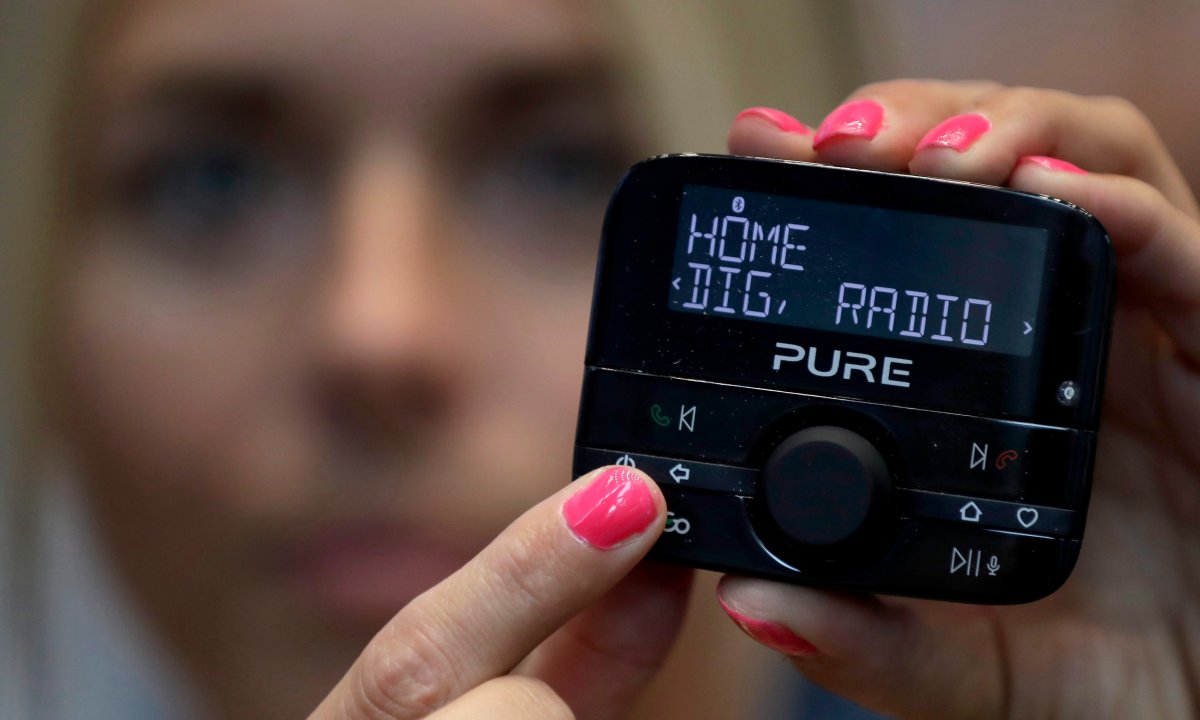Heat waves are becoming supercharged as the climate changes – lasting longer, becoming more frequent and getting just plain hotter. One question a lot of people are asking is: “When will it get too hot for normal daily activity as we know it, even for young, healthy adults?”
The answer goes beyond the temperature you see on the thermometer. It’s also about humidity. Our research shows the combination of the two can get dangerous faster than scientists previously believed.
Futurist
There are 390 posts filed in Futurist (this is page 1 of 39).
Albuquerque made itself drought-proof. Then its dam started leaking. • Source New Mexico
Mark Garcia can see that there’s no shortage of water in the Rio Grande this year. The river flows past his farm in central New Mexico, about 50 miles south of Albuquerque. The rush of springtime water is a welcome change after years of drought, but he knows the good times won’t last.
As the summer continues, the river will diminish, leaving Garcia with a strict ration. He’ll be allowed irrigation water for his 300 acres just once every 30 days, which is nowhere near enough to sustain his crop of oats and alfalfa.
For decades, Garcia and other farmers on the Rio Grande have relied on water released from a dam called El Vado, which collects billions of gallons of river water to store and eventually release to help farmers during times when the river runs dry. More significantly for most New Mexico residents, the dam system also allows the city of Albuquerque to import river water from long distances for household use.
But El Vado has been out of commission for the past three summers, its structure bulging and disfigured after decades in operation — and the government doesn’t have a plan to fix it.
“We need some sort of storage,” said Garcia. “If we don’t get a big monsoon this summer, if you don’t have a well, you won’t be able to water.”
Source: Albuquerque made itself drought-proof. Then its dam started leaking. • Source New Mexico
Opinion | The Pentagon is learning how to change at the speed of war – The Washington Post
For several decades, military reformers such as retired Navy Capt. Jerry Hendrix have pleaded with the Pentagon to stop buying wildly expensive but vulnerable aircraft carriers and fighter jets and instead focus on getting vast numbers of cheap drones. But nobody seemed to listen.
“Buy Fords, Not Ferraris” was the title of Hendrix’s iconoclastic 2009 polemic for inexpensive survivable systems. Aircraft carriers, he wrote, “have become too expensive to operate, and too vulnerable to be risked in anything other than an unhostile environment.” Similar arguments applied to exquisite systems beloved by all the services.
Source: Opinion | The Pentagon is learning how to change at the speed of war – The Washington Post
How is HD Radio doing in Canada? It depends | Globalnews.ca
Back in 1999, a man in a van pulled up. “Wanna hear something cool?” Inside was a Digital Audio Broadcasting (DAB) receiver, demonstrating the fidelity of digital signals from an experimental transmitter in Toronto, including programming from my station, 102.1 the Edge/Toronto. It sounded great. Better than great, in fact.
Born out of a European research project in 1995, DAB promised static-free, CD-quality, better-than-FM audio. And it did. The new technology was also far more efficient, cramming more radio signals into the same bandwidth, something that was appealing to markets with AM and FM dials at maximum capacity. Its successor, DAB+, uses substantially less electricity than power-hungry AM and FM transmitters. The prediction was that it was just a matter of time before DAB replaced analogue AM and FM broadcasts. “Soon,” we were told. And then … nothing. At least in North America.
Source: How is HD Radio doing in Canada? It depends | Globalnews.ca
Elon Musk Weighs in on the Encryption Wars Between Telegram and Signal
The encryption wars brewing between the messaging apps Telegram and Signal have attracted the commentary of a high-profile critic: Elon Musk.
Musk, who previously championed Signal for its user privacy protections, now appears to have changed his tune, amplifying criticisms of the app and its leadership and saying there are unspecified “known vulnerabilities” within Signal that have gone unaddressed by the company’s leadership.
Given his influence in the tech sphere, Musk’s remarkable reversal on Signal has become central to the current conversation on encryption — and, according to one cryptography expert, is pushing users toward less secure alternatives.
Source: Elon Musk Weighs in on the Encryption Wars Between Telegram and Signal
Faced with RTO mandates, some top tech talent left instead – The Washington Post
Return-to-office mandates at some of the most powerful tech companies — Apple, Microsoft and SpaceX — were followed by a spike in departures among the most senior, tough-to-replace talent, according to a case study published last week by researchers at the University of Chicago and the University of Michigan.
Researchers drew on resume data from People Data Labs to understand the impact that forced returns to offices had on employee tenure, and the movement of workers between companies. What they found was a strong correlation between senior-level employees departing directly after a mandate was implemented, suggesting these policies “had a negative effect on the tenure and seniority of their respective workforce.” High-ranking employees stayed several months less than they might have without the mandate, the research suggests — and in many cases, they went to work for direct competitors.
At Microsoft, the share of senior employees as a portion of the company’s overall workforce declined more than 5 percentage points after the return-to-office mandate took effect, the researchers found. At Apple, the decline was 4 percentage points, while at SpaceX — the only company of the three to require workers to be fully in-person — the share of senior employees dropped 15 percentage points.
Source: Faced with RTO mandates, some top tech talent left instead – The Washington Post
The Pentagon is lying about UFOs | The Hill
According to Gaetz, fighter pilots tracked four unknown objects flying in a “clear diamond formation.” Notably, the incident occurred on a training range typically conspicuously free of any airborne clutter.
In a case resolution report published last week, the Pentagon’s UFO analysis office concluded with “moderate” confidence that the object observed by the pilot was a balloon, likely “a large commercial lighting balloon.”
This so-called explanation insults the intelligence of any reader who takes a few moments to review the details of the incident. It did not convince the world’s most prominent UFO skeptic. The pilot’s sketch of the object, described as akin to an “Apollo spacecraft,” bears no plausible resemblance to the design of any known industrial lighting balloon.
Hello and Goodbye to Google Fiber

As y’all may know, I’ve been a booster of Google Fiber for a while. I signed us up for it the first day it became available. This week, I switched us back to AT&T. Let me explain why.
The server that hosts this website, my neighborhood mailing list, and other Internet stuff lives in a datacenter in Atlanta. I don’t really notice this, though, because the AT&T Fiber’s routing is excellent! I get super-low latency of 16 ms for my round-trip pings. I can’t reach many cross-town servers much faster than that. When I switched us over to Google Fiber, that round-trip time jumped to 60-100 ms. I researched whether my hosting provider’s datacenters in other cities were any better but it turns out Google Fiber is not nearly as good as AT&T’s. The city with the fastest server Google Fiber could get me to was Dallas which – as you geography buffs will note – is significantly farther from Raleigh than Atlanta. Go figure.
Please note that I’m a network nerd and my tech needs are, um, … unique. Normal people would probably not notice this stuff.
Being temporarily “dual-homed” with Google and AT&T meant I could negotiate rates. When I called to cancel AT&T, they offered me my same package at 30% off for 1 year (i.e., cheaper than Google and I can renew the deal next year). We now get for $60 what before we got for $90. Praise competition!
Google Fiber is still connected to our house (their fiber is still “lit.”) We’re not locked into AT&T with any contract so if AT&T pisses me off we can switch back without any trouble. Google just wants their WiFi Access Points back, which I didn’t use anyway.
There is also part of me that feels that a little bait-and-switch took place with Google Fiber. When Google Fiber was announced, I was under the impression that Google would devote its massive resources to making it a success. Instead, the company changed focus almost immediately, drastically putting on the brakes to its deployments. It was clear Google was not willing to make the investments necessary to make Google Fiber a healthy concern for the next fifty years. Google’s obsessively focused on its short-term stock market performance. It does not make investments the way railroads do, or like providers that expect to be relevant in 50 years, like AT&T.
Google Fiber switched to micro-trenching for its network installations. It also outsourced its installs to companies like Prime Telecom. I had multiple crews try to put in fiber, only to have me interrupt their installations because they were either bringing the fiber to the wrong side of our house or they were digging without doing utility locating. In hindsight, I suppose they usually skip the locating because it’s time-consuming and their shallow trenches rarely affect other buried utilities. They’d rather take the chance of busting something else than wait for lines to be marked. I don’t think this is a very professional game plan, personally.
Google Fiber does offer something unique, and that’s 2 Gbps service, twice as fast as our current service. This would be appealing to me but it is asymmetrical and the upload speed is still limited to 1 Gbps. I’d also have to upgrade all of our home networking gear to the new 2.5 Gbps standard. Well, technically I could use Google’s Wifi6 Access Points to go 2 Gbps but I want to use all the copper I’ve put into our house, rather than rely on WiFi. So, until Google makes the 2 Gbps service symmetrical I’ll stick with single-gigabit speeds.
All that being said, gigabit internet rocks! Saying goodbye to Spectrum forever rocks! Competition rocks! If you can get gigabit fiber, either through Google or AT&T, I recommend you do it. You will be happy you did!
The SARS-CoV-2 coronavirus takes over the world
Life as we know it has changed in an astonishingly quick moment. Last week it was fairly normal when it looked like China might be able to contain the virus but then panic set in across the country. Sports leagues like the NBA, NCAA, ACC, and NHL canceled their games. Raleigh’s Saint Patrick’s Day parade was called off. Then Wake County Public Schools decided last Friday to not count absences before turning around on Saturday and closing schools. A week ago I worked my first day at home and have not been back to the office except for a brief time Saturday to retrieve the plants off my desk.
We are doing what is termed “social distancing,” where we interact with as few people as possible. The kids are at home, Kelly and I are at home and we have largely given up any trips outside of the house except for dire emergencies. It is frightening and surreal. In an instant life has changed drastically.
It has been day three of our all being at home. Our home is big enough that we can find our own corners and not disturb each other. When we’re sharing our home office, Kelly has complained about how loudly I chew gum (narrator: it’s not that loud). Spirits are high now but the realization is setting in that this will not be over any time soon. We may have to shelter in place like this for months.
The saving grace is that we are not strictly confined to our homes. At least, not yet. We can go for drives, walks, bike rides, dog walks. Whatever. We are just encouraged to maintain that six-foot distance experts suggest will keep us safe from getting the SARS-CoV-2 coronavirus that causes COVID-19.
Continue reading
Do not lose heart. We were made for these times. | Clarissa Pinkola Estés, Ph.D.
The reason is this: In my uttermost bones I know something, as do you. It is that there can be no despair when you remember why you came to Earth, who you serve, and who sent you here. The good words we say and the good deeds we do are not ours: They are the words and deeds of the One who brought us here.
In that spirit, I hope you will write this on your wall: When a great ship is in harbor and moored, it is safe, there can be no doubt. But … that is not what great ships are built for.
This comes with much love and prayer that you remember Who you came from, and why you came to this beautiful, needful Earth.
Source: Do not lose heart. We were made for these times. | Clarissa Pinkola Estés, Ph.D.







